There is a lot of noise about gutter protection and the right type of gutter guard. Filters, covers, hoods, helmets – it can be confusing when educating yourself on the differences. With all the variety in the Kansas City market and across the U.S., you’re not sure which way to go when it comes to protecting your gutter systems. What are the pros and cons of each?
We’re going to help you out by comparing the differences between gutter guards, covers, and filters and screens.
Gutter Guards

Gutter guards completely cover the gutters to block debris from entering the channels. In turn, their goal is to allow precipitation to flow away from the roof and into downspouts situated in different areas around a home’s roofline.
You can categorize gutter guards into two categories – inserts and custom-molded gutters. The latter is what we do at K-Guard. Our custom gutter guard system features a separate hood and trough held in place with our patented, high-impact, all-weather polymer hangers. This ensures that the hood will never separate from the trough.
Inserts or guards are used by “filter” focused companies. Instead of a cover that is molded onto the gutter channels, leaf filters are gutter guards that are inserted into existing setups. Thus, customers allegedly save money because they don’t need to replace their entire gutter system.
However, this may not be the case. If you do decide to choose filters, make sure the insert completely covers both sides of the gutter. Some customers have reported debris in the channels that come in from the roof-side of the equipment. In other situations, precipitation pours completely over the guards instead of into the rain opening. This results in flooding in attics and basements and on driveways.
Gutter Screens
Gutter screens (or filters) contain small holes across its width. The circumference of these spaces is designed so only precipitation can feed into them. However, small debris like leaf fragments, whirlybirds, and wind-carried dirt can and will seep through. Nevertheless, the items are so small that manufacturers say they filter into the downspouts without any clogs.
 These filters are sold as snap-ins at most home improvement stores. There are several downsides to this. First, you may need to return to the store a few times if you don’t properly measure your gutters. Second, newer filters might not fit on all gutters, particularly those on older or historic homes. Finally, you may have to perform the installation by yourself, which can not only be tricky, but also dangerous without professional help.
These filters are sold as snap-ins at most home improvement stores. There are several downsides to this. First, you may need to return to the store a few times if you don’t properly measure your gutters. Second, newer filters might not fit on all gutters, particularly those on older or historic homes. Finally, you may have to perform the installation by yourself, which can not only be tricky, but also dangerous without professional help.
Proper installation is particularly critical, especially if you plan to do it yourself. If you don’t tightly connect screens the first time, debris can slide into the gutters. Or, it could be removed completely during a powerful storm.
The most important thing to understand about filters is that they are not maintenance-free. Just like any filter, they need to be cleaned and maintained. Without professional help, you will likely have to use a ladder to regularly clean debris out of any filtered gutter system.
Gutter Covers
 Gutter covers are like gutter guards. However, instead of a flat surface, covers have a reverse curve design. This supposedly filters debris while capturing all rain that flows from the roof.
Gutter covers are like gutter guards. However, instead of a flat surface, covers have a reverse curve design. This supposedly filters debris while capturing all rain that flows from the roof.
They take the reverse curve one step further. Its surface is textured to trap precipitation from completely flowing over the gutters.
Those who have used gutter covers in the past do have complaints. For instance, the debris filters sometimes fail, so items can collect and cause clogs. In addition, the covers themselves can be easily damaged simply by placing a ladder on them. If broken in this manner, then the lifetime warranty is void, not to mention they install under your roof’s shingles, which also may void any roof warranty.
What Option Is Best for You?
If you want a truly maintenance-free solution and an end to the anxiety of gutter maintenance visit our Contact Us page and schedule a FREE estimate. However, feel free to educate yourself on alternative covers, guards, and screens. Maybe even check out our gutter guide for new homeowners. When done, we’re confident you’ll understand why the K-Guard Leaf-Free Gutter System is the most advanced on the market.




